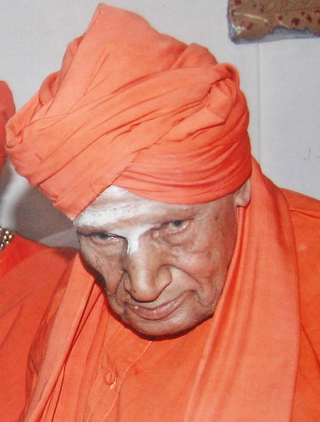
Tumkur, officially Tumakuru, is a city and headquarters of Tumakuru district in the Karnataka state of India. Tumkur is known for Siddaganga Matha. Tumkur hosts India's first mega food park, a project of the ministry of food processing. The India Food Park was inaugurated by Prime Minister of India in September 2014. Tumkur is also included in the Smart Cities Mission list and is among the 100 smart cities to be developed in India. Since 28 August 2010, Tumkur has been accorded the status of a city corporation.

Shivakumara Swami was an Indian humanitarian, spiritual leader, educator and supercentenarian. He was a Veerashaiva religious figure. Swami joined the Siddaganga Matha in 1930 Karnataka and became head seer in 1941. He also founded the Sri Siddaganga Education Society. Described as the most esteemed adherent of Lingayatism (Veerashaivism), he was referred to as Nadedaaduva Devaru in the state. In 2015, Dr Shivakumara Swamiji was awarded by the Government of India the Padma Bhushan, India's third highest civilian award.
Kallur is a village in the Gubbi subdistrict of the Tumkur district of Karnataka state in India. It has a Gram Panchayat. The village is located on the bank of the Shimsha river. It is mainly known for its handloom silk sarees. The handloom work is being performed traditionally, this work is transferred from their ancestors. The major caste in this village is Hindu Devanga and (lingayatha).
Bukkapatna is a village in the southern state of Karnataka, India. It is located in the Sira taluk of Tumkur district in Karnataka.
Holavanahalli is a village located in the southern state of Karnataka, India. It is located in the Koratagere taluk of Tumkur district in Karnataka.
Kenkere is a small town in the southern state of Karnataka, India. It is located in the Chiknayakanhalli taluk of Tumkur district in Karnataka. It is the headquarters of the Village Panchayat.
Madalur is a village in the southern state of Karnataka, India. It is located in the Sira taluk of Tumkur district in Karnataka.
Adagondanahalli is a village in the southern state of Karnataka, India. It is located in the Gubbi taluk of Tumkur district in Karnataka.
Adlapura is a village in the southern state of Karnataka, India. It is located in the Tumkur taluk of Tumkur district in Karnataka.
Agalagunte is a village in the southern state of Karnataka, India. It is located in the Tumkur taluk of Tumkur district.
Agalakote is a village in the southern state of Karnataka, India. It is located in the Tumkur taluk of Tumkur district in Karnataka.
Agarahara is a village in the southern state of Karnataka, India. It is located in the Tiptur taluk of Tumkur district in Karnataka.

Agrahara, Sira is a village in the southern state of Karnataka, India. It is located in the Sira taluk of Tumkur district in Karnataka.

Ahobala Agrahara is a village in the southern state of Karnataka, India. It is located in the Tumkur taluk of Tumkur district in Karnataka.

Ajjagonahalli is a village in the southern state of Karnataka, India. It is located in the Tumkur taluk of Tumkur district in Karnataka.

Ajjenahalli, Turuvekere is a village in the southern state of Karnataka, India. It is located in the Turuvekere taluk of Tumkur district in Karnataka.

Akkajihalli is a village in the southern state of Karnataka, India. It is located in the Koratagere taluk of Tumkur district in Karnataka.

Akkalasandra is a village in the southern state of Karnataka, near Dombaranahalli India. It is located in the Turuvekere taluk of Tumkur district in Karnataka.

Akkathangiyarakatte Kaval is a village in the southern state of Karnataka, India. It is located in the Tumkur taluk of Tumkur district.

Hikkal is a hill in Urdigere Taluk, Tumkur District, and Karnataka State, India. It is approximately 16 km from the district's main city of Tumkur, and 70 km away from the capital city Bangalore. The hill houses a temple of Lord Srinivasa in the form of a stone resembling a ripped ant hill; Idols of goddesses Sridevi and Bhudevi are also present. The nearby village is named after the hill Hikkal and the deity Srinivasa is called Hikkallappa. There is also an idol of Balaji, which was installed in 1999. It was presented by the Tirumala Tirupathi Devasthanam (TTD) of Andhra Pradesh which recognised this temple as one of the 108 sub-shrines of the original deity at Tirumala.









